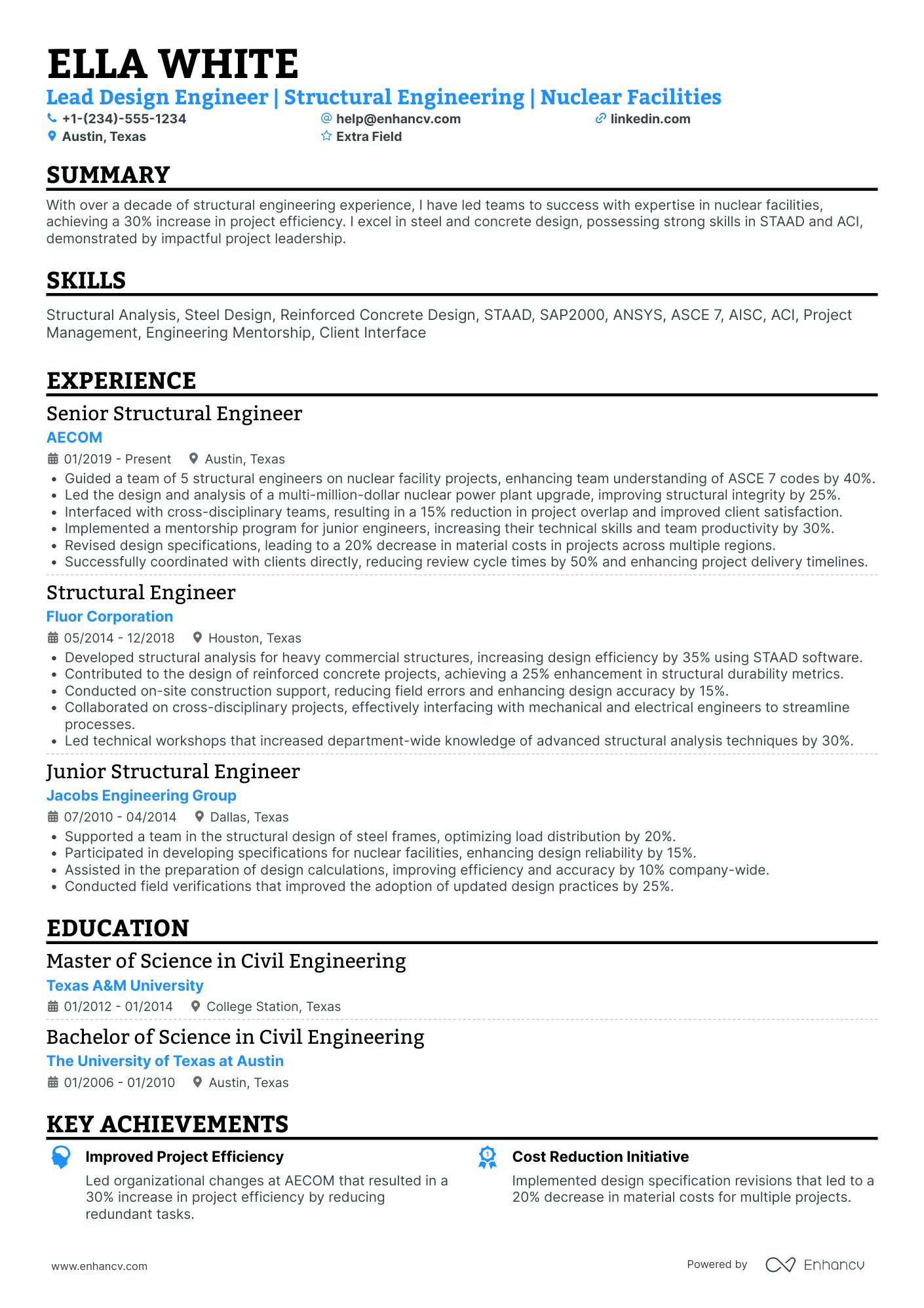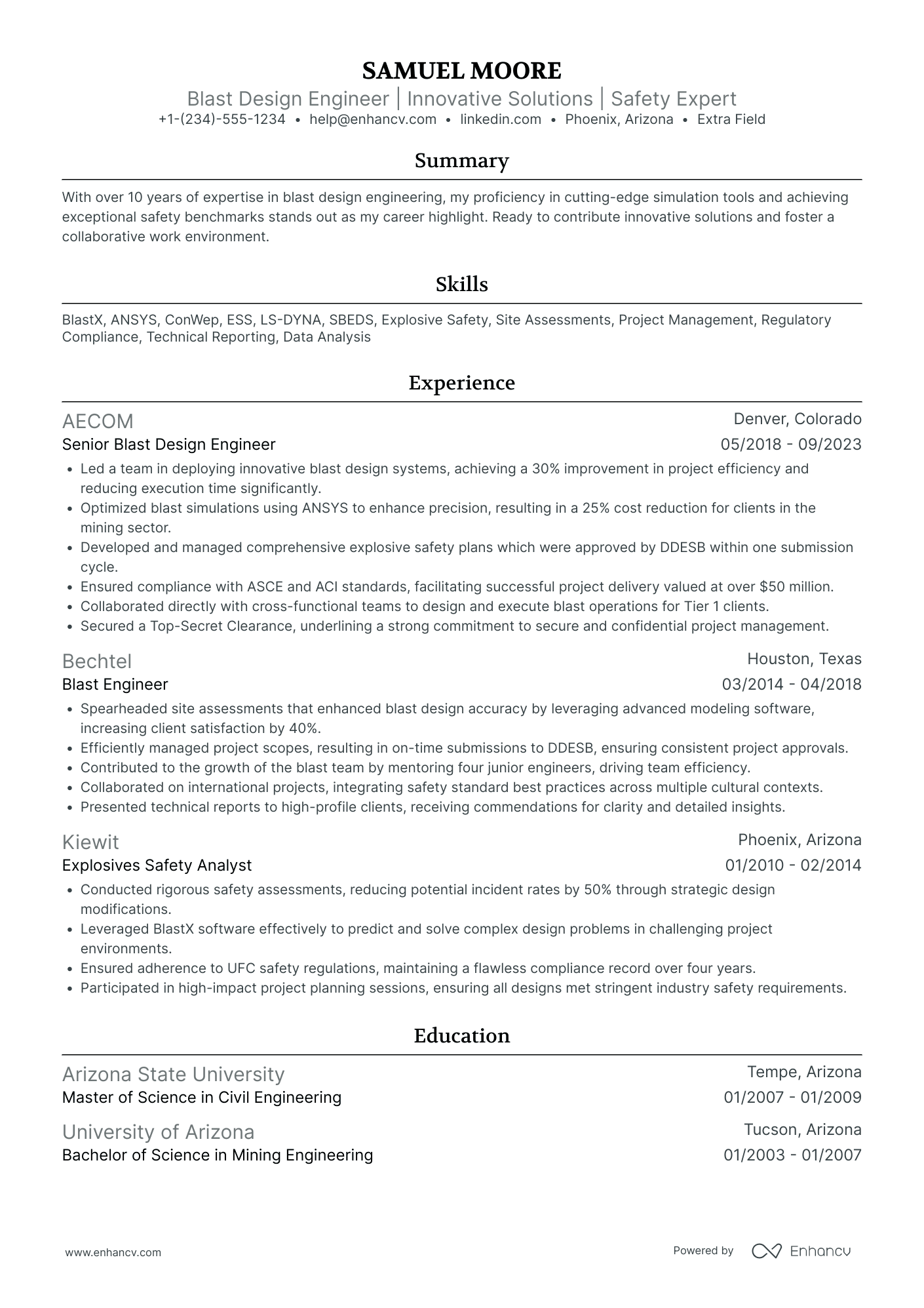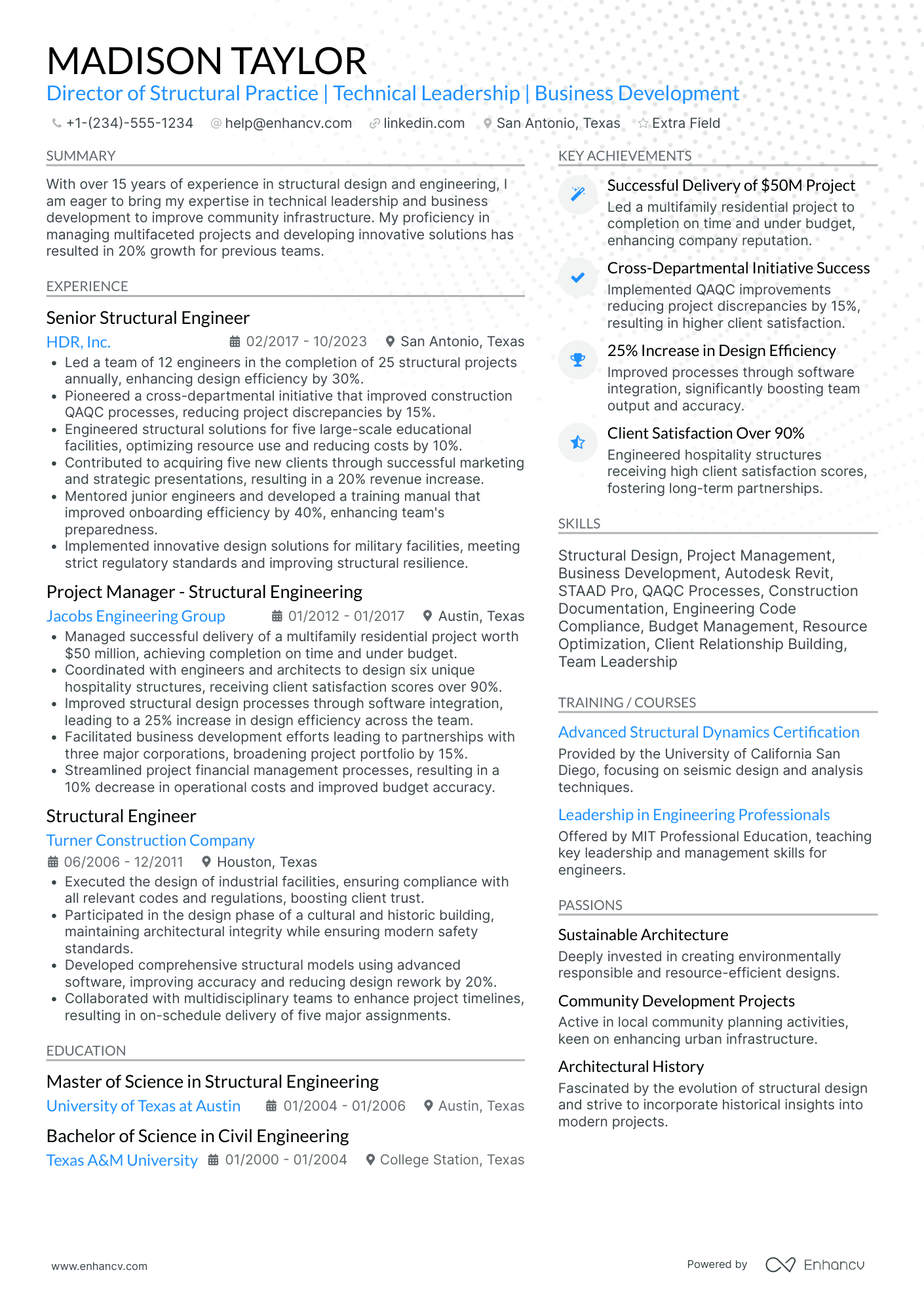How to write a job-winning structural engineer resume?
As a structural engineer, you have one of the most important roles in the construction industry.
You are responsible for ensuring that buildings and structures are safe for people to be in! A hiring manager needs to trust that you have the skills and expertise for this extremely important job before they hire you.
What’s the best way to prove you have what it takes?
You need to write the perfect structural engineering resume that highlights your:
- Relevant experience
- Engineering skills
- Education and qualifications
If you don’t display yourself in the best light with your resume, you won’t get considered for the job.
But don’t worry, we’re here to help you get it right. Follow along with this step-by-step guide on how to write your resume, so you can get hired in no time.
Looking for related resumes?
How to write an excellent structural engineer resume
You are the go-to person to ensure a structure stays secure and safe for a long time.
Your resume shows how people can rely on you to do this job well.
Structural engineers are required to recognize potential pressures and stresses, and know how to communicate these findings to the rest of the construction team.
The top structural engineer applicants have resumes that combine both their technical knowledge and their ability to work well with a team. We’ll show you how exactly to do this, later in the guide!
Include technical skills that show you understand the impact of structural loads: live, dead and environmental.
Highlight your soft skills in your summary and work experience section.
How did you manage your budgets?
How did you communicate your findings with the architects and property developers?
Real numbers and data help set you yourself apart with a structural engineer resume.
Talk about how many structures you evaluated, the budgets you were working with, and the impact you’ve made on the projects.
Most importantly, tailor your structural engineer resume to the job’s industry and to the job posting itself.
Are they in the railway industry? Do they need someone with a working knowledge of AutoCAD and Tekla/Tedds? Are they only hiring candidates with Chartered status?
Take note of these details and make them the focus of your structural engineer resume.
Here’s what a recruiter will look for in your resume
- Do you have a clear understanding of all loads and forces that can affect the integrity of structures?
- Have you worked with a variety of clients including architects, designers, contractors and property developers?
- What kind of companies have you worked with in the past? (eg. Railway operators, engineering consultancies, public utility companies, etc.)
- What is your educational background? Do you have extra qualifications or do you have Chartered status?
The most important sections of a mechanical design engineer resume
- Resume header that grabs the recruiter’s attention
- Summary that highlights your knowledge
- Formal education in engineering
- Technical and soft skills - both are needed
Each of these structural engineer resume sections should build trust with the recruiter and show them why you’re the best fit for the role. Let’s walk you through this.
How to write a winning structural engineer resume header
You’re applying for an engineering consultancy as a Senior structural engineer.
Here’s the basic header you may already have:
This is acceptable. It includes your main points.
But it definitely won’t stand out among the stack of other resumes. It’s a generic header that doesn’t highlight your level of expertise.
The hiring manager will get their first impression of you from your resume header. It’s on the top of the page - the first thing they will read.
Let’s paint a better picture about who you are with a more compelling resume header.
Hiring managers know right away that you’re a senior-level structural engineer with Chartered status.
Quantitative data is key on a structural engineer resume
You need to build trust with the hiring manager with your structural engineer resume. What’s the fastest way to do this?
Include real numbers and data to prove your past success as a structural engineer.
Numbers that can prove the effectiveness of your past work:
- How many structures did you evaluate?
- What kind of budgets did you work with?
- How many team members did you consult with?
These figures bring your summary and experience section to life. They make the hiring manager eager to interview you.
Let’s jump into how to do this.
Prove you’re right for the job in your structural engineer professional summary
A structural engineer resume summary should prove that you are both technically competent and an excellent communicator.
Can you make sure a structure can handle forces, while also working with the entire construction team to stay on-budget and on-time?
Use the quantitative data we just spoke about and the keywords in the job description to write an effective summary.
Optimize your resume summary and objective for ATS
Drop your resume here or choose a file.
PDF & DOCX only. Max 2MB file size.
2 structural engineer Resume Samples - Summary
Here’s an example of a weak resume summary.
This summary won’t help you stand out from other candidates. Why?
- There’s no mention of how many years of experience you have.
- It’s generic. The recruiter or hiring manager will know you’re applying to many other positions with this resume.
- It’s missing specific skills mentioned in the job posting.
Here’s an example of a summary that will land you an interview:
Now this is a strong summary. It includes all the essentials, including:
- A detailed description of who you are (incl. seniority level and Chartered status)
- Quantitative data describing the success of your former projects
- Direct mention of soft skills in your ability to work with team members
- Trust-building with the note about your health & safety record
Pro tip
Don’t just list your job title. Add more descriptive detail, like your seniority level and any extra qualifications or statuses you hold.
After you have your summary written, it’s time to move onto improving the experience section of your structural engineer resume.
How should you highlight your experience as a structural engineer
Emphasize two main points when highlighting your structural engineering experience: your problem-solving skills and your ability to work closely with a team.
Problem-solving is the biggest part of your job as a structural engineer. You need to identify structural weaknesses during site visits and identify solutions on how to solve them.
You rarely work alone as a structural engineer.
Even if you’re the only engineer on the team, you need to liaise with the project manager, contractor, architect, homeowner, etc. to get the job done.
You can’t lack communication skills as a structural engineer. Reporting your findings, meeting with the construction team and staying on top of project management are key skills you must highlight in your past experience.
We’ll compare a few structural engineer resume examples for what works and what falls flat in the experience section.
2 structural engineer Resume Experience Samples
This is your time to shine in the experience section. Here’s a handy checklist to run through when writing a synopsis for every former position you held as a structural engineer:
- What was the goal of the company when you arrived?
- What were the quantitative results of your work?
- How did you work with your teammates to achieve this goal?
Let’s check out two examples of structural engineer experience sections. One is done well, and the other needs more work. Can you spot them?
- •Worked with the construction team on projects
- •Used various software tools to complete analyses
- •Completed site visits
This experience section makes employee seem dispassionate about their role. There is no detail on their success in the role - it just lists of their responsibilities.
- •Performed calculations of stresses on all areas of the buildings
- •Used AutoCAD and Tekla to design and assess structural integrity
- •Liaised with clients on projects ranging in budget from $5-15 million
- •Ensured legal, health and safety guidelines were maintained
This example displays passion and knowledge for the industry, with specific examples and figures to highlight past success in the role. The hiring manager will have way more confidence for the candidate after reading this.
How to describe the duties of a structural engineer on a resume
Here are some sample work experience responsibilities to consider for your structural engineer resume:
- Used software (such as AutoCAD) to design models of structures
- Conducting site visits and writing site visit reports
- Design calculations for structures
- Work with architects on design models
- Review submittals
- Ensure legal, health and safety guidelines are maintained
What should you include in your structural engineer resume education section?
Formal education is essential to get a job as a structural engineer. You should include a well structured education section in your resume!
Hiring managers are looking to see that you have a Bachelor of Engineering degree. Many companies even require that you have a Master’s degree.
These are the two most common degrees accepted for a structural engineering role:
- Structural engineering
- Civil Engineering
If you don’t have any formal education, some engineering companies offer graduate training schemes, so you can get your foot in the door.
Pro tip
Gaining incorporated engineer status or chartered engineer status is a helpful goal to work towards, if you don’t already have it. Many senior-level jobs require chartered status, and it puts you leagues ahead of other candidates.
How to include certifications on your structural engineer resume
Certifications show the hiring manager that you’ve been formerly trained in different areas of structural engineering.
While they can’t replace an engineering university degree, they do make a positive impact on your resume, since they show your dedication to the industry.
Always list the certifications mentioned or required in a structural engineer job description first. Then, include other certifications you have.
The Institution of structural engineers offer certifications and diplomas to further your education and they offer professional membership grades:
Getting these membership grades will boost your chances of getting hired.
Which skills do employers look for in a structural engineer resume?
Proficiency in recognising pressures and stresses in a structural analysis is key for this industry.
You should be familiar with different loads, including live, dead and environmental.
You will need to be proficient in using computer software, such as AutoCAD, to demonstrate your findings and produce design models of structures.
Aside from these technical skills, a huge component of being a reliable and successful structural engineer is your ability to communicate your findings.
Since you’ll be working closely with the entire construction team, having a strong soft skills will go a long way in getting you hired.
Tasks like producing helpful reports, problem-solving, managing budgets, and communicating issues during meetings are extremely important for the job.
Here is a comprehensive list of both technical and soft skills to add to your resume skill section:
12 Technical Skills to Include on a structural engineer Resume
- Structural analysis
- Understanding of thermal technology
- Loads: live, dead and environmental
- Develop construction plans
- Risk analysis
- Sketching for visualizations
- AutoCAD
- Tekla
- Tedds
- Solidworks
- FEA
- Ansys
12 soft skills to include on a structural engineer resume
- Decision making
- Project management
- Excellent numeracy skills
- Communication skills (written & spoken)
- Analytical skills
- Problem solving
- Collaborating with a team
- High attention to detail
- Work to tight deadlines
- Stick to budgets
- Producing reports
- Client liaison
Being able to communicate is a key [skill]. If I’ve sat down and run some analysis and decided that something isn’t going to fit together properly on-site… I need to explain to the [contractors] what the problem is that I foresee, and also communicate how we’re going to start to solve the problem. I can’t just highlight problems, I have to provide the solutions as well. That’s such a key element of what I have to do.
George Brown, Structural Engineer at Fairhurst
Summary: what are the top tips for the best structural engineer resume
- Include real facts and quantitative data to prove past success
- Highlight your credentials, such as having Chartered status
- List the design and analysis software you’re most proficient with
- Discuss the soft skills that will help you be successful in your job
- Note the keywords used in the job description and input them in your resume sections
Structural Engineer resume examples
By Experience
Junior Structural Engineer
Structural Engineer II
Senior Structural Engineer
Lead Structural Engineer
By Role


































